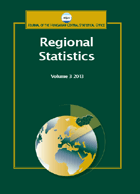Changes in administration, spatial structure, and
demography in the Partium region since the Treaty of Trianon
Changes in administration, spatial structure, and
demography in the Partium region since the Treaty of Trianon
Author(s): Ferenc Szilágyi, Tibor ElekesSubject(s): History, Social Sciences, Economy, Geography, Regional studies
Published by: Központi Statisztikai Hivatal
Keywords: border region; spatial structure; territorial-administrative system; demographic change
Summary/Abstract: Following the Trianon decision, the name Partium re-emerged, this time as the name of a major region. When the border was defined,the infrastructure track over rode the ethnic, catchment, historic, administrative, and terra individing lines in the region. The previously balanced ethnic structure of the region's population has changed to a Romanian majority. In terms of spatial structure, the former market line has become a periphery,where only a few gateway cities managed to remain economically successful due to logistical reasons.The new frontier suddenly eliminated the competitive situations of some city-pairs (for example Debrecen–Oradea, Szeged–Arad), creating new ones instead (Timişoara–Arad,Oradea–Cluj, Satu Mare–Baia Mare). The large cities that found themselves on the Romanian side of the border could not compete for major developments because their positions were strategically difficult to defend. Therefore, a peripherization of the border region took place. The ethnic change in the cities took place before the fall of Communism, while the population change in the suburban areas is taking place today.
Journal: Regional Statistics
- Issue Year: 10/2020
- Issue No: 01
- Page Range: 101-119
- Page Count: 19
- Language: English

